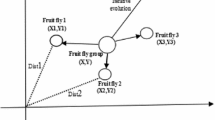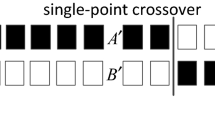Abstract
Annual power load forecasting is essential for the planning, operation and maintenance of an electric power system, which can also mirror the economic development of a country to some extent. Accurate annual power load forecasting can provide valuable references for electric power system operators and economic managers. With the development of Energy Internet and further reformation of electric power market, power load forecasting has become a more difficult and challenging task. In this paper, a new hybrid annual power load forecasting model based on LSSVM (least squares support vector machine) and MFO (Moth-Flame Optimization algorithm) is proposed, which the parameters of LSSVM model are optimally determined by the latest nature-inspired metaheuristic algorithm MFO. Meanwhile, the rolling mechanism is also employed. The forecasting results of China’s annual electricity consumption indicate the proposed MFO-LSSVM model shows much better forecasting performance than single LSSVM, FOA-LSSVM (LSSVM optimized by fruit fly optimization), and PSO-LSSVM (LSSVM optimized by particle swarm optimization). MFO, as a new intelligence optimization algorithm, is attractive and promising. The LSSVM model optimized by MFO can significantly improve annual power load forecasting accuracy.









Similar content being viewed by others
References
Sanstad AH, McMenamin S, Sukenik A, Barbose GL, Goldman CA (2014) Modeling an aggressive energy-efficiency scenario in long-range load forecasting for electric power transmission planning. Appl Energy 128:265–276
Zakariazadeh A, Jadid S, Siano P (2014) Stochastic operational scheduling of smart distribution system considering wind generation and demand response programs. Int J Electr Power Energy Syst 63:218–225
Al-Hamadi H, Soliman S (2005) Long-term/mid-term electric load forecasting based on short-term correlation and annual growth. Electr Power Syst Res 74:353–361
Wang J, Li L, Niu D, Tan Z (2012) An annual load forecasting model based on support vector regression with differential evolution algorithm. Appl Energy 94:65–70
Hamzacebi C, Es HA (2014) Forecasting the annual electricity consumption of turkey using an optimized grey model. Energy 70:165–171
Li H-Z, Guo S, Li C-J, Sun J-Q (2013) A hybrid annual power load forecasting model based on generalized regression neural network with fruit fly optimization algorithm. Knowl-Based Syst 37:378–387
Hamzaçebi C (2007) Forecasting of turkey’s net electricity energy consumption on sectoral bases. Energy Policy 35:2009–2016
Pao H-T (2009) Forecast of electricity consumption and economic growth in taiwan by state space modeling. Energy 34:1779–1791
Kavousi-Fard A, Samet H, Marzbani F (2014) A new hybrid modified firefly algorithm and support vector regression model for accurate short term load forecasting. Expert Syst Appl 41:6047–6056
Bahrami S, Hooshmand R-A, Parastegari M (2014) Short term electric load forecasting by wavelet transform and grey model improved by pso (particle swarm optimization) algorithm. Energy 72:434–442
Li D-C, Chang C-J, Chen C-C, Chen W-C (2012) Forecasting short-term electricity consumption using the adaptive grey-based approach—an asian case. Omega 40:767–773
Li G-D, Wang C-H, Masuda S, Nagai M (2011) A research on short term load forecasting problem applying improved grey dynamic model. Int J Electr Power Energy Syst 33:809–816
Hong W-C, Dong Y, Zhang WY, Chen L-Y, Panigrahi B (2013) Cyclic electric load forecasting by seasonal svr with chaotic genetic algorithm. Int J Electr Power Energy Syst 44:604–614
Dong R, Pedrycz W (2008) A granular time series approach to long-term forecasting and trend forecasting. Phys A: Stat Mech Appl 387:3253–3270
Kandil M, El-Debeiky SM, Hasanien N (2002) Long-term load forecasting for fast developing utility using a knowledge-based expert system. IEEE Trans Power Syst 17:491–496
Hsu C-C, Chen C-Y (2003) Regional load forecasting in taiwan—-applications of artificial neural networks. Energy Conver Manag 44:1941–1949
Xia C, Wang J, McMenemy K (2010) Short, medium and long term load forecasting model and virtual load forecaster based on radial basis function neural networks. Int J Electr Power Energy Syst 32:743–750
Jia N, Yokoyama R, Zhou Y, Gao Z (2001) A flexible long-term load forecasting approach based on new dynamic simulation theory—gsim. Int J Electr Power Energy Syst 23:549–556
Hong W-C (2009) Electric load forecasting by support vector model. Appl Math Modell 33:2444–2454
Chen T (2012) A collaborative fuzzy-neural approach for long-term load forecasting in taiwan. Comput Indust Eng 63:663–670
Pai P-F, Hong W-C (2005) Support vector machines with simulated annealing algorithms in electricity load forecasting. Energy Conver Manag 46:2669–2688
Pai P-F, Hong W-C (2005) Forecasting regional electricity load based on recurrent support vector machines with genetic algorithms. Electr Power Syst Res 74:417–425
Zhao H, Guo S, Xue W (2015) Urban saturated power load analysis based on a novel combined forecasting model. Information 6:69–88
Cortes C, Vapnik V (1995) Support-vector networks. Mach Learn 20:273–297
Van Gestel T, Suykens JA, Baesens B, Viaene S, Vanthienen J, Dedene G, De Moor B, Vandewalle J (2004) Benchmarking least squares support vector machine classifiers. Mach Learn 54:5–32
Suykens JA, Vandewalle J (1999) Least squares support vector machine classifiers. Neural Process Lett 9:293–300
Suykens JA, De Brabanter J, Lukas L, Vandewalle J (2002) Weighted least squares support vector machines: Robustness and sparse approximation. Neurocomputing 48:85–105
Zhou J, Shi J, Li G (2011) Fine tuning support vector machines for short-term wind speed forecasting. Energy Conver Manag 52:1990–1998
Yeganeh B, Motlagh MSP, Rashidi Y, Kamalan H (2012) Prediction of co concentrations based on a hybrid partial least square and support vector machine model. Atmospher Environ 55:357–365
Lin K-P, Pai P-F, Lu Y-M, Chang P-T (2013) Revenue forecasting using a least-squares support vector regression model in a fuzzy environment. Inf Sci 220:196–209
Wu H, Chang X (2006) In Power load forecasting with least squares support vector machines and chaos theory. In: WCICA 2006. The Sixth World Congress on Intelligent Control and Automation, 2006. IEEE, pp 4369–4373
Wu Q (2011) Hybrid model based on wavelet support vector machine and modified genetic algorithm penalizing gaussian noises for power load forecasts. Expert Syst Appl 38:379–385
Li J, Liu J, Wang J Mid-long term load forecasting based on simulated annealing and svm algorithm. Proc CSEE 2011 31:63– 66
Liao R, Zheng H, Grzybowski S, Yang L (2011) Particle swarm optimization-least squares support vector regression based forecasting model on dissolved gases in oil-filled power transformers. Electr Power Syst Res 81:2074–2080
Dos Santos GS, Luvizotto LGJ, Mariani VC, Dos Santos Coelho L (2012) Least squares support vector machines with tuning based on chaotic differential evolution approach applied to the identification of a thermal process. Expert Syst Appl 39:4805–4812
Wolpert D, Macready W (1997) No free lunch theorems for optimization. IEEE Transactions on Evolutionary Computation 1:67–82
Igel C (2014) No free lunch theorems: Limitations and perspectives of metaheuristics. In: Theory and principled methods for the design of metaheuristics. Springer, pp 1–23
Mirjalili S (2015) Moth-flame optimization algorithm: A novel nature-inspired heuristic paradigm. Knowl-Based Syst 89:228–249
Gaston KJ, Bennie J, Davies TW, Hopkins J (2013) The ecological impacts of nighttime light pollution: A mechanistic appraisal. Biol Rev 88:912–927
van Langevelde F, Ettema JA, Donners M, WallisDeVries MF, Groenendijk D (2011) Effect of spectral composition of artificial light on the attraction of moths. Biol Conser 144:2274– 2281
Amiri M, Davande H, Sadeghian A, Chartier S (2010) Feedback associative memory based on a new hybrid model of generalized regression and self-feedback neural networks. Neural Netw 23:892–904
Acknowledgments
The authors are grateful to the editor and anonymous reviewers for their suggestions in improving the quality of the paper. This research is partially funded by the National Natural Science Foundation of China (71271084), the Fundamental Research Funds for the Central Universities (2014XS55 and 2015XS32) and the Project for The Beijing’s Enterprise-Academics-Research Co-Culture Post-Graduate.
Author information
Authors and Affiliations
Corresponding author
Ethics declarations
Conflict of interests
The authors declare that there is no conflict of interest regarding the publication of this paper.
Rights and permissions
About this article
Cite this article
Li, C., Li, S. & Liu, Y. A least squares support vector machine model optimized by moth-flame optimization algorithm for annual power load forecasting. Appl Intell 45, 1166–1178 (2016). https://doi.org/10.1007/s10489-016-0810-2
Published:
Issue Date:
DOI: https://doi.org/10.1007/s10489-016-0810-2




